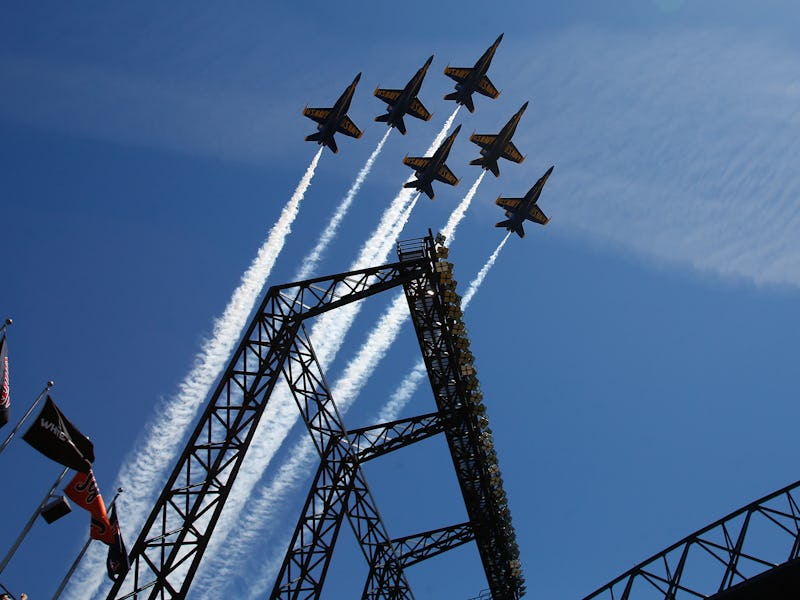Here's How Much a Military Jet Flyover Costs on July 4
The Blue Angels don't come cheap.

The sound of a fighter jet flying overhead is unforgettable. For decades, the U.S. military has been showing off its engines during military flyovers at sporting events, parades, celebrations, and of course, the Fourth of July. Heck, President Donald Trump even had the first one since the 50s at his presidential inauguration. But you can’t pay for air power with just patriotism: flyovers cost money, and figuring out exactly how much is a little bit complicated.
On the Fourth of July, cities across America will incorporate flyovers into their celebrations this year. The cost of a flyover is a bit difficult to determine, however, as it depends on the type of plane used, the location, and how many planes are flying. The short answer is, for any kind of active jet flyover, it’s going to be well over $100,000 — but the real answer could be much more than that.
Take the 2011 Super Bowl, for example. The media widely reported that the military flyover during halftime cost taxpayers $450,000. Air Force officials, however, claim that the only cost it records is the fuel cost to fly the jets, which it says was $109,000.
Part of this discrepancy is that flyover missions are usually classified as training missions, the costs for which are included in a unit’s operational budget for the year. Some units, like the Blue Angels, do not fly combat missions, and exist just for propaganda and show purposes (the individual pilots assigned to the Blue Angels, however, may rotate in and out of combat assignments elsewhere).
In 2012, KQED News found that the DoD budgeted $39 million for the Blue Angels, who put on shows for 69 days that year. In 2013, the DoD considered slashing flyovers at sporting events to save money, suspending missions by the Air Force Thunderbirds (a similar unit to the Navy’s Blue Angels) until they resumed in 2014. An Air Force spokesperson told USA Today at the time that the Air Force flew up to 1,000 flyovers a year, but that most of them were just snippets of longer training missions. In other words, the planes would be on other, multi-hour missions simulating war games or other training flights in the sky, which would include a quick 90-second buzz of the local stadium.
A better way to calculate the cost of a flyover, perhaps, would be to look at the operational cost of the plane in question. The Blue Angels fly F/A-18 Hornets (in a few different variants) and the Thunderbirds fly F-16 Fighting Falcons. The F/A-18s cost between $10,500 and $13,310 per hour (depending on configuration and user), according to the DoD’s 2016 financial management report.
The Blue Angels usually fly six at a time, meaning the operational costs are between $60,000 and $80,000 per hour — so depending on how long the flyover mission is, things could get expensive quickly. The Thunderbirds are a bit cheaper — F-16 variants cost between $8,242 and $8,701 per hour to fly. F-16s seem to be a common choice for the Fourth, as well — South Carolina’s Salute from the Shore over Myrtle Beach will have an F-16 wing flyover in the afternoon, before fireworks start.
In 2017, however, some towns will be getting an even pricier show in the sky. Several cities in Utah are getting a flyover from the military’s newest bird, the much-maligned F-35 Lightning II. The F-35, according to the same data, costs between $28,455 and $29,685 per hour to fly, so Utah is clearly getting some of the priciest patriotism in the country this year.
In any case, military flyovers can quickly rack up a bill unlike any other celebration, including the most gratuitous of fireworks. Happy Fourth, y’all, and make sure to stay out of the Danger Zone.